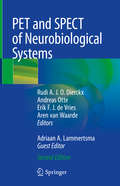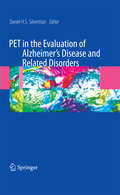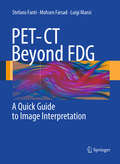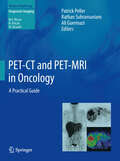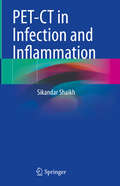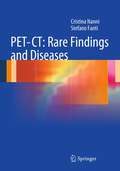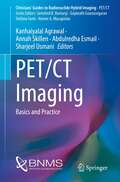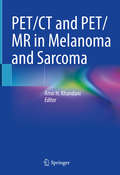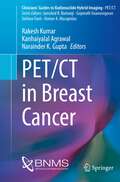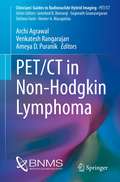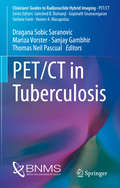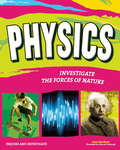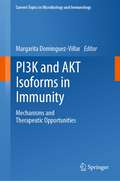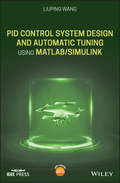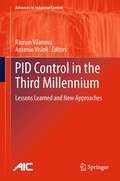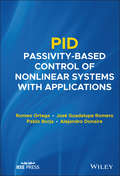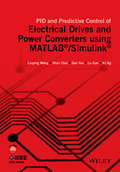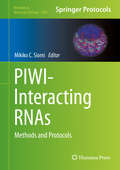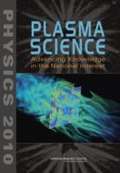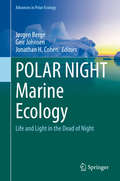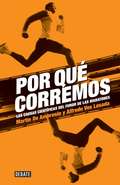- Table View
- List View
PET and SPECT of Neurobiological Systems
by Andreas Otte Erik F. J. de Vries Rudi A. J. O. Dierckx Aren Van Waarde Adriaan A. LammertsmaThis book, now in a fully updated second edition, is a comprehensive and up-to-date guide to the use of PET and SPECT for the imaging of neurobiological systems. Diverse aspects of neurotransmission in the brain are discussed, such as visualization and quantification of neuroreceptors, neuroinflammatory markers, transporters, and enzymes as well as neurotransmitter synthesis, β-amyloid deposition, cerebral blood flow, and the metabolic rate of glucose. The latest results in probe development are also detailed. A wide range of systems not addressed in the first edition are covered, reflecting the advances made in recent years. The book combines the expertise of authors internationally renowned for their dedication to the development of novel probes and techniques for the investigation of neurobiological systems. Most chapters are written jointly by radiochemists and nuclear medicine specialists to ensure a multidisciplinary approach. This state of the art compendium will be valuable to all with an interest in clinical and preclinical neuroscience. Companion volumes on the use of PET and SPECT in neurology and psychiatry complete a trilogy.
PET in the Evaluation of Alzheimer's Disease and Related Disorders
by Dan SilvermanThis practical guide contains all the science and clinical information needed to help the reader make informed decisions about the applications of brain PET to improve the care of patients with symptoms of Alzheimer's disease and related disorders. Beginning with an introduction to goals and limitations of the clinical evaluation of dementia, Dr. Dan Silverman and his distinguished group of contributors cover the role of functional imaging, clinical interpretation of brain FDG-PET scans, FDG-PET in the evaluation of early dementia, microstructural imaging of neurodegenerative changes, amyloid imaging, imaging non-neurodegenerative causes of cognitive impairment, tools for assisting PET scan interpretation in the clinical setting, and PET evaluation of central motor disorders. There is also a complete collection of clinical cases that practitioners are likely to encounter in daily practice. Enhanced with numerous PET brain scans, this book fills a rapidly growing need in the medical imaging field.
PET-CT Beyond FDG
by Mohsen Farsad Stefano Fanti Luigi MansiAlthough [18F]fluorodeoxyglucose (FDG) generally shows an excellent performance as a cancer-imaging agent when using PET-CT, there are some settings in which other radiopharmaceuticals offer advantages. Such non-FDG tracers are now gaining widespread acceptance not only in research but also in clinical practice. This atlas, including about 500 high-quality images, is a user-friendly guide to PET-CT imaging beyond FDG. A wide range of tracers is covered, such as 18F- and 11C-choline, 11C-methionine, 18F-ethyl-L-tyrosine, 68Ga-DOTA-NOC, 11C-acetate, 11C-thymidine, and 18F-DOPA. Throughout, the emphasis is on image interpretation, with guidance on the recognition of normal, benign, and malignant uptake and clear instruction on learning points and pitfalls. This atlas is designed to serve as a reference text for both nuclear physicians and radiologists, and will also be of great benefit to radiographers, technologists, and nuclear medicine and radiology residents.
PET-CT and PET-MRI in Oncology
by Patrick Peller Rathan Subramaniam Ali GuermaziOver the past decade, PET-CT has achieved great success owing to its ability to simultaneously image structure and function, and show how the two are related. More recently, PET-MRI has also been developed, and it represents an exciting novel option that promises to have applications in oncology as well as neurology. The first part of this book discusses the basics of these dual-modality techniques, including the scanners themselves, radiotracers, scan performance, quantitation, and scan interpretation. As a result, the reader will learn how to perform the techniques to maximum benefit. The second part of the book then presents in detail the PET-CT and PET-MRI findings in cancers of the different body systems. The final two chapters address the use of PET/CT in radiotherapy planning and examine areas of controversy. The authors are world-renowned experts from North America, Europe, and Australia, and the lucid text is complemented by numerous high-quality illustrations.
PET-CT in Infection and Inflammation
by Sikandar ShaikhThis book covers all aspects of PET-CT including newer applications involving infection and inflammation and basic information on PET-CT new tracers. It explains the approach, protocols and miscellaneous applications about various infections and inflammation that helps in its early and better diagnosis in multiorgan and multisystem involvements in routine clinical practice.Chapters provide systematic approach to the diagnosis of various infections such as bacterial, viral, tuberculosis, inflammatory pathologies and overlap in coexisting tumors and superadded/associated infections. This book offers assistance to medical practitioners in understanding various advantages of PET-CT in single scan as compared to different modalities for diagnosis as well as oncologists dealing with concurrent malignant and non-malignant conditions, students, and interns.
PET-CT: Rare Findings and Diseases
by Stefano Fanti Cristina NanniPET-CT is increasingly being employed in the diagnosis of both oncological and non-oncological patients, yet nuclear medicine physicians may have only limited practical experience of rare diseases and may experience difficulty in recognizing and interpreting rare findings. This unique atlas documents a large number of clinical cases that will help practitioners to identify findings and diseases that, though rare, are sufficiently frequent to be encountered in routine practice. Two types of cases are presented: patients evaluated for rare diseases and patients evaluated for standard diseases in whom atypical PET findings were detected. Each reported case includes a brief description of the clinical history, representative color PET-CT images obtained using FDG or other tracers, and a short explanation of the disease and findings. This atlas will enable practitioners to make conclusive reports of PET-CT scans that would otherwise have been inconclusive.
PET/CT Imaging: Basics and Practice (Clinicians’ Guides to Radionuclide Hybrid Imaging)
by Kanhaiyalal Agrawal Annah Skillen Abdulredha Esmail Sharjeel UsmaniThe aim of this book is to provide concise information and quick reference on the basics and practice of PET/CT for beginners. The chapters are written by Nuclear Medicine experts from different countries with enormous experience in PET/CT practice. Starting with the basics of PET/CT describing physics and the use of radiopharmaceuticals in PET/CT, the book explores the principle of PET/CT in radiotherapy planning. The last five chapters explore normal variation, pitfalls and artefacts commonly seen with various routinely used PET radiotracers. The text is enriched by tables and highlighted clinical cases for better understanding. This book will be of interest mostly to nuclear medicine physicians and radiologists, but it may be appealing also to a wider medical community including oncologists and radiotherapists.
PET/CT and PET/MR in Melanoma and Sarcoma
by Amir H. KhandaniThis is a comprehensive guide for patient preparation, image acquisition, and image interpretation for PET/CT and PET/MR, specifically relevant to melanoma and sarcoma. Imaging specialists and referring physicians are often not as intimately aware of the particulars of PET imaging in management of patients with melanoma and sarcoma and how it could affect their treatment. This book fills that gap by presenting comprehensive information on melanoma, sarcoma, and the role of PET imaging in their diagnosis and management. The book begins by covering the basics of imaging for practicing physicians and trainees. Expert authors then further cover the biological concepts of melanoma and sarcoma and how they relate to imaging, particularly PET, the oncologist’s perspective, and the surgeon’s perspective on imaging for both the imaging specialist and the referring physician. Chapters review topics such as: PET/CT and PET/MR images in melanoma and sarcoma from a systemic approach, false-positives, false-negatives, pitfalls, and molecular imaging beyond PET. Images are used extensively throughout to enhance understanding for the reader. This is an ideal guide for radiologists, nuclear medicine physicians, oncologists, surgeons, trainees and technologists.
PET/CT in Breast Cancer (Clinicians’ Guides to Radionuclide Hybrid Imaging)
by Rakesh Kumar Kanhaiyalal Agrawal Narainder K. GuptaThe aim of this book is to provide crisp information related to pathology, management and radiological/molecular imaging in breast carcinoma, along with detailed information on FDG PET-CT in breast cancer, normal variants, artefacts, pitfalls with atlas illustrations. The book is unique in providing quick reference to practice of PET/CT in breast cancer. The initial few chapters are related to the pathology and management of breast carcinoma to help understand the pathophysiology of breast cancer before going to the imaging. The chapter on imaging in breast cancer highlights the role of different imaging modalities for different indications to the reader. The last four chapters describe in detail the role, normal variants, artefacts and pitfalls of FDG PET/CT along with recent molecular imaging advances in breast cancer.Written by Pathology, Oncology, Radiology and Nuclear Medicine experts from different countries with enormous experience in breast cancer practice, the book addresses nuclear medicine physicians and radiologists, but it may be of interest to a wider medical community, including oncologists and radiotherapists.
PET/CT in Non-Hodgkin Lymphoma (Clinicians’ Guides to Radionuclide Hybrid Imaging)
by Archi Agrawal Venkatesh Rangarajan Ameya D. PuranikThis book provides an up-to-date summary of the latest scientific developments on the use of PET-CT imaging in Non-Hodgkin Lymphoma (NHL). It encompasses the entire spectrum of NHL – from pathology to radiological and PET-CT imaging and to the management of NHL. The highlight of the book is the excellent pictorial depiction of normal variants, pitfalls and artifacts while exploring the different types of NHL and its manifestations. Each chapter, written by well-known and experienced oncologists and physicians, is enriched by a wide range of images to ensure a clear concept of PET-CT imaging in NHL and will definitely keep the readers interested.This book will be a useful tool for nuclear physicians, radiologists, referring clinicians and oncologists, as well as para-medical staff working in this field.
PET/CT in Tuberculosis (Clinicians’ Guides to Radionuclide Hybrid Imaging)
by Dragana Sobic Saranovic Mariza Vorster Sanjay Gambhir Thomas Neil PascualThis book covers both the science of PET/CT imaging in tuberculosis and the impact that this technique can have on disease management through the provision of high-quality evidence regarding function and structure. The scientific principles of PET/CT, the radiopharmaceuticals used in the context of tuberculosis (FDG and non-FDG tracers), patient preparation, and imaging protocols are fully explained. Imaging findings obtained in different settings, including pulmonary and extrapulmonary tuberculosis, tuberculosis and HIV co-infection, and evaluation of response to antituberculous therapy, are described with the aid of many high-quality illustrations. Attention is drawn to mimics of tuberculosis, pitfalls, and limitations. The book will be an excellent asset for referring clinicians, nuclear medicine/radiology physicians, radiographers/technologists, and nurses who routinely work in nuclear medicine and participate in multidisciplinary meetings.
PET/MR: Functional and Molecular Imaging of Neurological Diseases and Neurosciences
by Jie Lu Guoguang ZhaoThis book aims to summarize the research progress of integrated PET/MR brain function and molecular imaging, and more importantly, clinical application and research status of PET/MR of brain imaging from brain diseases to brain science. Starting from the overviews of brain function imaging technology, following chapters introduces clinical application of integrated PET/MR specific brain diseases in details, such as Alzheimer's disease, Parkinson's disease, epilepsy, and brain tumor, etc., which are hot issues of brain science research. It will be a useful reference to residents and practitioners in nuclear medicine, radiology, and neurology, as well as those interested in molecular imaging of brain.
PHYSICS
by Jane P. Gardner Samuel CarbaughHave you ever noticed that the physical world works in certain ways? When you push an object it moves. Skateboarders use force and motion to perform tricks. If you jump up as high as you can, you'll quickly fall back to the ground. Baseball players use gravity to bring the ball back down when they throw it. When you flip a switch, electricity powers your toaster. Rock bands use electricity to put on a show. The fascinating science of physics helps you understand why forces, motion, gravity, electricity, light, and sound work in predictable ways.Combining inquiry-based, age-appropriate activities with physics topics, Physics: Investigate the Forces of Nature features graphic novel illustrations, fascinating sidebars, youtube links, and a glossary of important vocabulary to illuminate the complex world of physics and bring it to life. Projects include designing a skateboard park that maps the forces at work on the skateboarder and the skateboard, arguing your way out of a speeding ticket using the properties of physics, and creating a stage design for a rock band that places electric current where it is needed. Additional materials include a list of current reference works, websites, and Internet resources.
PI3K and AKT Isoforms in Immunity: Mechanisms and Therapeutic Opportunities (Current Topics in Microbiology and Immunology #436)
by Margarita Dominguez-VillarThis book provides an essential overview of the role of phosphoinositide-3-phosphate kinase (PI3K) isoforms in modulating the function of immune system cells and their involvement in disease.PI3K is a family of kinases involved in basic cellular processes such as proliferation, migration and cell death. Recent work has highlighted the multiple roles of PI3K classes and subunits and their involvement in the immune response to the body’s own and foreign antigens and diseases such as cancer and autoimmunity. This book offers a detailed introduction to the biology of the three PI3K classes, followed by an extensive discussion of the diverse roles of AKT and PI3K isoforms in immune cells. Based on this knowledge, it subsequently explains in more detail how specific isoforms are connected to immune-mediated diseases. The book concludes by highlighting the latest advances in the production of isoform-specific inhibitors and their use in various human diseases. This book is intended as a reference guide for students and researchers interested in the multifaceted aspects of PI3K biology.
PICTURING QUANTUM PROCESSES: A First Course in Quantum Theory and Diagrammatic Reasoning
by Bob Coecke Aleks KissingerThe unique features of the quantum world are explained in this book through the language of diagrams, setting out an innovative visual method for presenting complex theories. Requiring only basic mathematical literacy, this book employs a unique formalism that builds an intuitive understanding of quantum features while eliminating the need for complex calculations. This entirely diagrammatic presentation of quantum theory represents the culmination of ten years of research, uniting classical techniques in linear algebra and Hilbert spaces with cutting-edge developments in quantum computation and foundations. Written in an entertaining and user-friendly style and including more than one hundred exercises, this book is an ideal first course in quantum theory, foundations, and computation for students from undergraduate to PhD level, as well as an opportunity for researchers from a broad range of fields, from physics to biology, linguistics, and cognitive science, to discover a new set of tools for studying processes and interaction.
PID Control System Design and Automatic Tuning using MATLAB/Simulink (Wiley - IEEE)
by Liuping WangCovers PID control systems from the very basics to the advanced topics This book covers the design, implementation and automatic tuning of PID control systems with operational constraints. It provides students, researchers, and industrial practitioners with everything they need to know about PID control systems—from classical tuning rules and model-based design to constraints, automatic tuning, cascade control, and gain scheduled control. PID Control System Design and Automatic Tuning using MATLAB/Simulink introduces PID control system structures, sensitivity analysis, PID control design, implementation with constraints, disturbance observer-based PID control, gain scheduled PID control systems, cascade PID control systems, PID control design for complex systems, automatic tuning and applications of PID control to unmanned aerial vehicles. It also presents resonant control systems relevant to many engineering applications. The implementation of PID control and resonant control highlights how to deal with operational constraints. Provides unique coverage of PID Control of unmanned aerial vehicles (UAVs), including mathematical models of multi-rotor UAVs, control strategies of UAVs, and automatic tuning of PID controllers for UAVs Provides detailed descriptions of automatic tuning of PID control systems, including relay feedback control systems, frequency response estimation, Monte-Carlo simulation studies, PID controller design using frequency domain information, and MATLAB/Simulink simulation and implementation programs for automatic tuning Includes 15 MATLAB/Simulink tutorials, in a step-by-step manner, to illustrate the design, simulation, implementation and automatic tuning of PID control systems Assists lecturers, teaching assistants, students, and other readers to learn PID control with constraints and apply the control theory to various areas. Accompanying website includes lecture slides and MATLAB/ Simulink programs PID Control System Design and Automatic Tuning using MATLAB/Simulink is intended for undergraduate electrical, chemical, mechanical, and aerospace engineering students, and will greatly benefit postgraduate students, researchers, and industrial personnel who work with control systems and their applications.
PID Control in the Third Millennium
by Antonio Visioli Ramon VilanovaThe early 21st century has seen a renewed interest in research in the widely-adopted proportional-integral-differential (PID) form of control. PID Control in the Third Millennium provides an overview of the advances made as a result. Featuring: new approaches for controller tuning; control structures and configurations for more efficient control; practical issues in PID implementation; and non-standard approaches to PID including fractional-order, event-based, nonlinear, data-driven and predictive control; the nearly twenty chapters provide a state-of-the-art resumé of PID controller theory, design and realization. Each chapter has specialist authorship and ideas clearly characterized from both academic and industrial viewpoints. PID Control in the Third Millennium is of interest to academics requiring a reference for the current state of PID-related research and a stimulus for further inquiry. Industrial practitioners and manufacturers of control systems with application problems relating to PID will find this to be a practical source of appropriate and advanced solutions.
PID Passivity-Based Control of Nonlinear Systems with Applications
by Romeo Ortega Jose Guadalupe Romero Pablo Borja Alejandro DonaireExplore the foundational and advanced subjects associated with proportional-integral-derivative controllers from leading authors in the field In PID Passivity-Based Control of Nonlinear Systems with Applications, expert researchers and authors Drs. Romeo Ortega, Jose Guadalupe Romero, Pablo Borja, and Alejandro Donaire deliver a comprehensive and detailed discussion of the most crucial and relevant concepts in the analysis and design of proportional-integral-derivative controllers using passivity techniques. The accomplished authors present a formal treatment of the recent research in the area and offer readers practical applications of the developed methods to physical systems, including electrical, mechanical, electromechanical, power electronics, and process control. The book offers the material with minimal mathematical background, making it relevant to a wide audience. Familiarity with the theoretical tools reported in the control systems literature is not necessary to understand the concepts contained within. You’ll learn about a wide range of concepts, including disturbance rejection via PID control, PID control of mechanical systems, and Lyapunov stability of PID controllers. Readers will also benefit from the inclusion of: A thorough introduction to a class of physical systems described in the port-Hamiltonian form and a presentation of the systematic procedures to design PID-PBC for them An exploration of the applications to electrical, electromechanical, and process control systems of Lyapunov stability of PID controllers Practical discussions of the regulation and tracking of bilinear systems via PID control and their application to power electronics and thermal process control A concise treatment of the characterization of passive outputs, incremental models, and Port Hamiltonian and Euler-Lagrange systems Perfect for senior undergraduate and graduate students studying control systems, PID Passivity-Based Control will also earn a place in the libraries of engineers who practice in this area and seek a one-stop and fully updated reference on the subject.
PID and Predictive Control of Electrical Drives and Power Converters using MATLAB / Simulink
by Liuping Wang Shan Chai Dae Yoo Lu Gan Ki NgA timely introduction to current research on PID and predictive control by one of the leading authors on the subject PID and Predictive Control of Electric Drives and Power Supplies using MATLAB/Simulink examines the classical control system strategies, such as PID control, feed-forward control and cascade control, which are widely used in current practice. The authors share their experiences in actual design and implementation of the control systems on laboratory test-beds, taking the reader from the fundamentals through to more sophisticated design and analysis. The book contains sections on closed-loop performance analysis in both frequency domain and time domain, presented to help the designer in selection of controller parameters and validation of the control system. Continuous-time model predictive control systems are designed for the drives and power supplies, and operational constraints are imposed in the design. Discrete-time model predictive control systems are designed based on the discretization of the physical models, which will appeal to readers who are more familiar with sampled-data control system. Soft sensors and observers will be discussed for low cost implementation. Resonant control of the electric drives and power supply will be discussed to deal with the problems of bias in sensors and unbalanced three phase AC currents. Brings together both classical control systems and predictive control systems in a logical style from introductory through to advanced levels Demonstrates how simulation and experimental results are used to support theoretical analysis and the proposed design algorithms MATLAB and Simulink tutorials are given in each chapter to show the readers how to take the theory to applications. Includes MATLAB and Simulink software using xPC Target for teaching purposes A companion website is available Researchers and industrial engineers; and graduate students on electrical engineering courses will find this a valuable resource.
PIWI-Interacting RNAs
by Mikiko C. SiomiPIWI-interacting RNAs (piRNAs) are the third and most-recently discovered group of silencing-inducible small RNAs in animals. PIWI-Interacting RNAs: Methods and Protocols provides the most recent methods and protocols for studying piRNAs in the gonads of a wide range of species, as well as in any other organs where piRNAs may be detected. Comprehensive high-throughput sequencing analysis of piRNAs in embryos, testes and ovaries of D. melanogaster, as well as in mouse and rat testes, has raised the profile of piRNAs and thus further accelerated piRNA studies. In addition to C. elegans, other model species such as Drosophila melanogaster, Arabidopsis thaliana and mice, along with cultured cell lines such as HeLa and Drosophila Schneider 2 (S2), and other such organisms have been used to address the fundamental questions of the biogenesis and functions of RNAi-triggering small non-coding RNAs. Written in the successful Methods in Molecular Biology series format, chapters include introductions to their respective topics, lists of the necessary materials and reagents, step-by-step, readily reproducible protocols, and notes on troubleshooting and avoiding known pitfalls. Authoritative and easily accessible, PIWI-Interacting RNAs: Methods and Protocols seeks to serve both established researchers and newcomers to the field to progress towards the ultimate goal of understanding the mechanisms and actions of piRNAs.
PJ Time: 100 Bedtime Devotions to Light Up the Night
by Thomas NelsonYoung kids will learn fascinating nature facts as they grow in faith and settle down for peaceful sleep with these fun, short devotions about the wonders of the dark in the animal world, ocean, and night sky.Each of the 100 bedtime devotions explores an engaging nighttime topic: sleeping otters holding hands, the moon's glow, multiplying bubbles at bath time, and saying good night to God. Each entry includes cheerful illustrations and a final reflection on how to act out Jesus' love and truth.This delightful devotional for boys and girls ages 4–8 gives kids a fun way to close out the day withAdorable and amazing animals, incredible science facts, and the mysteries of the darkBible verses from the Old and New TestamentsPrayer starters to guide children in talking to God about their specific triumphs, struggles, and questionsQuiet time before sleepPJ?Time?is a wonderful way to help kids cozy up in their favorite PJs, spend time with God, and fall asleep knowing that God is always awake.
PLANT BREEDING: Classical to Modern
by P. M. PriyadarshanThis book offers a detailed overview of both conventional and modern approaches to plant breeding. In 25 chapters, it explores various aspects of conventional and modern means of plant breeding, including: history, objective, activities, centres of origin, plant introduction, reproduction, incompatibility, sterility, biometrics, selection, hybridization, methods of breeding both self- and cross- pollinated crops, heterosis, synthetic varieties, induced mutations and polyploidy, distant hybridization, quality breeding, ideotype breeding, resistance breeding, breeding for stress resistance, G x E interactions, tissue culture, genetic engineering, molecular breeding, genomics, gene action and varietal release. The book’s content addresses the needs of students worldwide. Modern methods like molecular breeding and genomics are dealt with extensively so as to provide a firm foundation and equip readers to read further advanced books. Each chapter discusses the respective subject as comprehensively as possible, and includes a section on further reading at the end. Info-boxes highlight the latest advances, and care has been taken to include nearly all topics required under the curricula of MS programs. As such, the book provides a much-needed reference guide for MS students around the globe.
PLASMA SCIENCE: Advancing Knowledge in the National Interest
by Plasma 2010 CommitteeAs part of its current physics decadal survey, Physics 2010, the NRC was asked by the DOE, NSF, and NASA to carry out an assessment of and outlook for the broad field of plasma science and engineering over the next several years. The study was to focus on progress in plasma research, identify the most compelling new scientific opportunities, evaluate prospects for broader application of plasmas, and offer guidance to realize these opportunities. The study paid particular attention to these last two points. This "demand-side" perspective provided a clear look at what plasma research can do to help achieve national goals of fusion energy, economic competitiveness, and nuclear weapons stockpile stewardship. The report provides an examination of the broad themes that frame plasma research: low-temperature plasma science and engineering; plasma physics at high energy density; plasma science of magnetic fusion; space and astrophysical science; and basic plasma science. Within those themes, the report offers a bold vision for future developments in plasma science.
POLAR NIGHT Marine Ecology: Life and Light in the Dead of Night (Advances in Polar Ecology #4)
by Geir Johnsen Jørgen Berge Jonathan H. CohenUntil recently, the prevailing view of marine life at high latitudes has been that organisms enter a general resting state during the dark Polar Night and that the system only awakens with the return of the sun. Recent research, however, with coordinated, multidisciplinary field campaigns based on the high Arctic Archipelago of Svalbard, have provided a radical new perspective. Instead of a system in dormancy, a new perspective of a system in full operation and with high levels of activity across all major phyla is emerging. Examples of such activities and processes include: Active marine organisms at sea surface, water column and the sea-floor. At surface we find active foraging in seabirds and fish, in the water column we find a high biodiversity and activity of zooplankton and larvae such as active light induced synchronized diurnal vertical migration, and at seafloor there is a high biodiversity in benthic animals and macroalgae. The Polar Night is a period for reproduction in many benthic and pelagic taxa, mass occurrence of ghost shrimps (Caprellides), high abundance of Ctenophores, physiological evidence of micro- and macroalgal cells that are ready to utilize the first rays of light when they appear, deep water fishes found at water surface in the Polar night, and continuous growth of bivalves throughout the winter. These findings not only begin to shape a new paradigm for marine winter ecology in the high Arctic, but also provide conclusive evidence for a top-down controlled system in which primary production levels are close to zero. In an era of environmental change that is accelerated at high latitudes, we believe that this new insight is likely to strongly impact how the scientific community views the high latitude marine ecosystem. Despite the overwhelming darkness, the main environmental variable affecting marine organisms in the Polar Night is in fact light. The light regime during the Polar Night is unique with respect to light intensity, spectral composition of light and photoperiod.
POR QUE CORREMOS? (EBOOK)
by LOSADA D.AMBROSIO-V.Por qué cada vez más gente se calza las zapatillas para correr por la ciudad? Hay alguna razón para este sacrificio autoimpuesto? O en realidad no es un sufrimiento, sino uno de los antiguos placeres de la especie? Correr genera adicción? Está en nuestros genes de sociedades nómadas? Es una respuesta al sedentarismo de la vida moderna? Hace dos millones de años que el ser humano corre, pero nunca antes tantas personas lo hicieron como ahora. Por eso, la ciencia comenzó a buscar respuestas en el cerebro de los maratonistas. Por qué corremos explica qué le sucede desde el punto de vista biológico y psicológico a las personas que corren y, sobre todo, a quienes desafían la resistencia de su cuerpo y de su mente en las maratones; qué satisfacción o sensación siente quien corre para superar el dolor y el agotamiento. Este libro mezcla las razones científicas y sociales del fenómeno con algunas historias de los grandes corredores de todos los tiempos y arma un combo veloz e inteligente.
